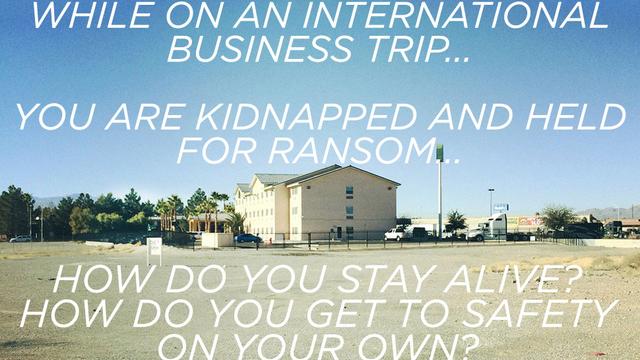In the meeting room of a La Quinta hotel on the northernmost outskirts of Las Vegas, near the entrance to Nellis Air Force Base, the company OnPoint Tactical hosted the most recent iteration of their “Urban Escape & Evasion” course.
“Urban Escape & Evasion” is a three-day workshop dedicated to training the general public — with an emphasis on international business travellers — how to avoid being kidnapped, how to escape from captivity if you are unfortunately nabbed, and how to navigate your way back to safety through unfamiliar urban terrain.
It is urban survivalism, complete with a hands-on introduction to improvised weaponry, lock-picking exercises, and a surreal final day spent putting those new skills to work, being hooded, interrogated, and — assuming you are able to escape your handcuffs in the dark — spending a day being tracked through the city by volunteer bounty hunters intent on showing how difficult it can be to find safety.
To date, the workshop has been held in such US cities as Los Angeles, Philadelphia, Atlanta, Chicago, Salt Lake City and many more; somewhat surprisingly, they have yet to run the workshop in New York City, as OnPoint Tactical founder Kevin Reeve thinks the reactions of local law enforcement officers would simply be too difficult to manage on the day of the final exercise.
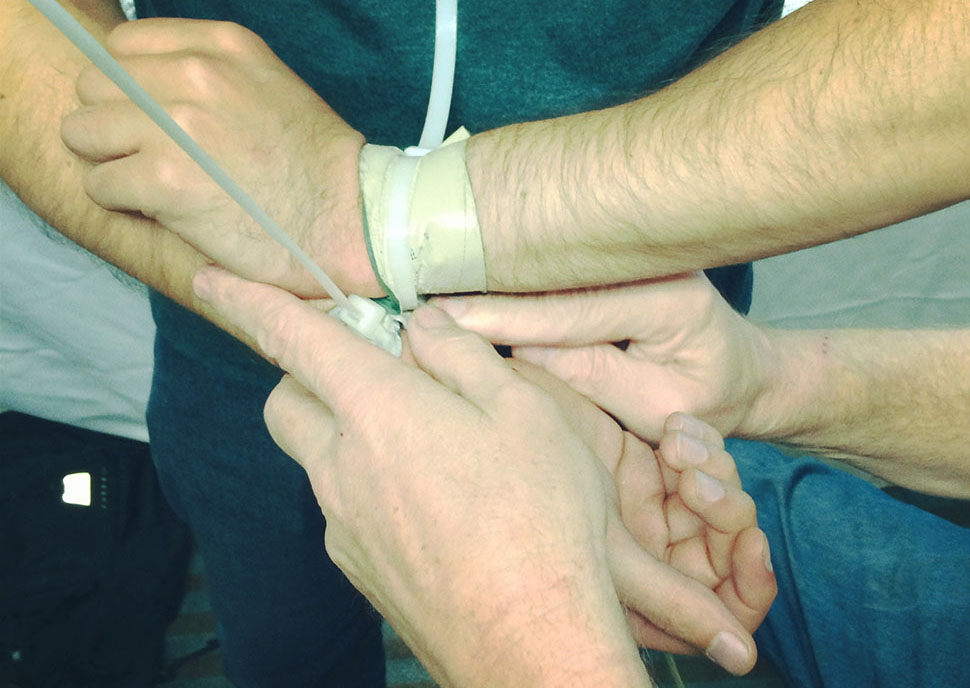
I signed up for the course in Las Vegas — it was actually a combination birthday/Christmas gift from my wife — and I had originally done so as part of the research I was doing for a book I’m writing about burglary, crime, and the built environment. I wanted to learn not only how to escape handcuffs, zip ties, and paracord — simply for the fun of it — but to hear how the urban environment itself might present spatial opportunities for everything from committing crimes to evading gangs and kidnappers.
The workshop’s focus on improvisational tools, DIY gear hacks, and the virtuoso navigation of urban space also made it a perfect fit for Gizmodo. While I can’t reveal all the specifics — for that, you’ll to sign up for one of the courses on the company’s website — read on for stories of a surreal weekend spent escaping from captivity, picking locks, and watching amateur kidnap films in the dust-covered, far-northern outskirts of Las Vegas.
“While on an international business trip…”
The overall premise of the workshop is that you find yourself in an unfamiliar environment, somewhere you can’t navigate on your own and where you don’t know the local customs. This could be Iraq or it could be Colombia — or it could be much closer to home, such as Detroit, a city that came up repeatedly in the anti-urban sentiments that underlaid most of the course. We were told repeatedly that this could happen in any city — you could be kidnapped anywhere or experience outright urban collapse, whether from a prolonged blackout or a natural disaster, in Phoenix as much as in Mexico City. If the future of violence is urban, then literally any conurbation is a risk.
Indeed, urbanism itself was presented not as a communitarian utopia of different individuals going about their business in peace, but as a series of dangerous scenarios that any businessperson or casual traveller might find both inexplicable and physically threatening.
Put another way, when some of us think of Detroit, we might think of urban farming and neighbourhood literary initiatives, a challenged city struggling to rise again and reestablish itself amidst the ruins. But others — those of us more likely to sign up for a workshop called “Urban Escape & Evasion” — picture roving gangs, feral dogs, and the problem of how best to conceal a handgun.
In fact, this is perhaps overly dismissive a way to phrase it, but I might even go as far as to say that this is a course for people scared to visit a big city — yet it masquerades as the ultimate in tough guy bravado. There was thus something oddly symbolic, almost like a Freudian slip, in the fact that, at one point, our work table was covered with handcuffs, tactical pocket knives, protein bars, and seemingly redundant cans of Monster Energy drinks — but also a colourful scattering of pink barrettes and sparkly hair clips for teenaged girls, hair products we would soon be taking apart to refashion as tools of escape.
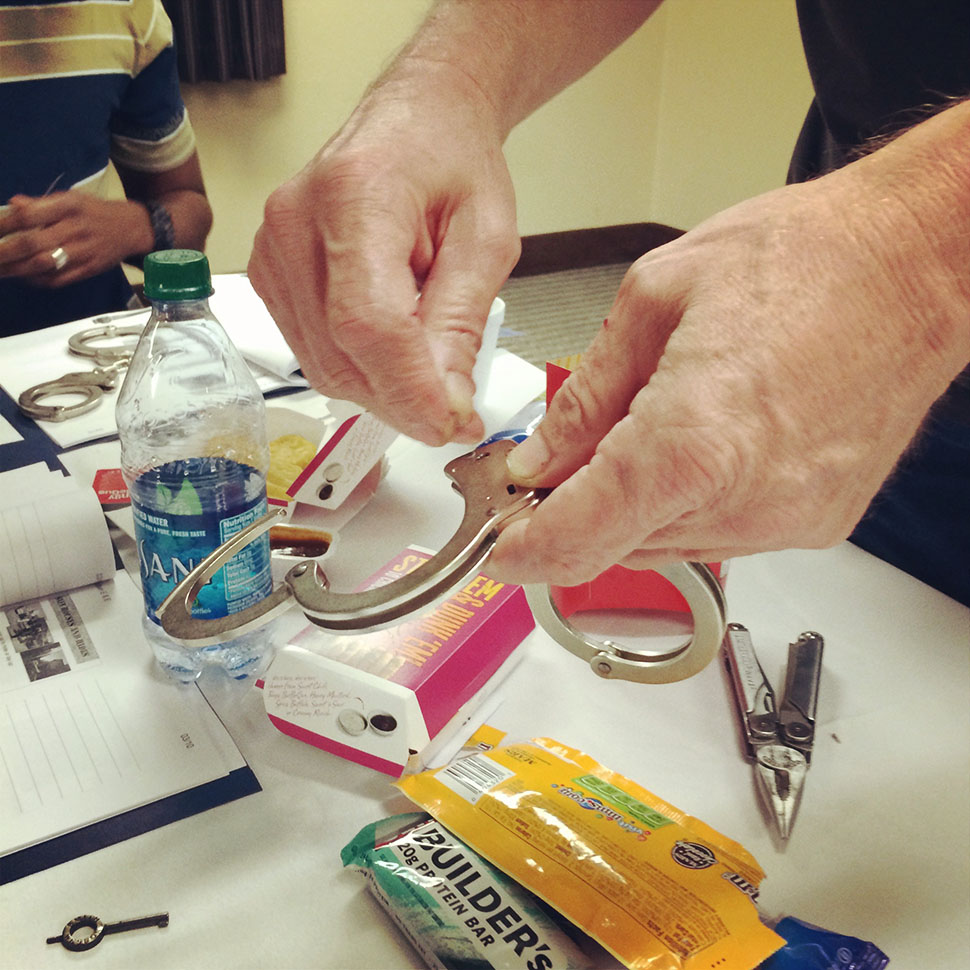
In any case, what was both so interesting and so troubling about the way cities were discussed during the workshop was that the very idea someone might choose to live in urban circumstances was presented as if there could hardly be an easier way to put oneself at risk of violence — whether it’s kidnapping or a fistfight — and that urban environments are where self-reliance goes to die.
That this might, in fact, work in exactly the opposite direction — that people actually escape from small towns and rural communities precisely to learn how to fend for themselves in unfamiliar circumstances, thus leading to a different kind of mental toughness and personal resilience — was not really up for discussion. Cities are where you go to be pampered or attacked, and there was seemingly no middle ground.

Las Vegas, a block or so away from the hotel where we trained.
Over the course of the weekend, we looked at hotel sieges (focusing specifically on Mumbai), we studied kidnapping vans (including a series of short videos from Eastern Europe and Central Asia that allegedly showed Al-Qaeda kidnappings), and we received a brief tutorial about which neighborhoods to avoid and which to make a beeline for if you are fleeing captivity or if society itself has imploded around you. That this was explicitly based on race — avoiding neighborhoods that are home to people who don’t share your skin colour — was presented as unarguable common sense.
Amidst advice for how to locate the cardinal directions in an unfamiliar city, we learned how to blend in, the importance of maintaining initiative by keeping moving, the difficulty of caching things (that is, hiding or burying goods around an environment for later retrieval), where to go for quick medical treatment (think veterinarians, not doctors), and even cheap and easy ways to fortify your hotel room against possible attacks.
At this point, for example, we learned to take lightweight plastic felling wedges and apply deck tape from skateboards to each side, adding both texture and traction. Now ram these beneath your hotel or apartment door and, unless someone chainsaws the door open, you have, at the very least, bought yourself some time to get out the window.
Reeve, who has a curious tendency to close his eyes, stop talking, put his hand on the bridge of his nose, concentrate for several seconds in silence, and then start speaking again, as if fighting off a headache, went deep into the gear one should accumulate, whether it’s to avoid an unpleasant situation overseas or simply to be prepared in the event of urban chaos back home — including the trustworthiness of a good bicycle, something Reeve learned first hand while nearly trapped at his office on the day the Loma Prieta earthquake hit back in 1989. In fact, hurricanes, blackouts, and earthquakes were all regular topics of conversation.
Fascinatingly, Reeve introduced us to the various online suppliers of tactical gear, such as SEREPICK. We learned that, like the secret menus available at some fast food restaurants, some of these sites have offline inventory that customers can only access if they make contact using a keyword (one of which we were provided) so that you can order the real goods.
However, the entire point of the workshop was that attendees should learn what to do next, after these tactics have failed and they have been captured.
“You are kidnapped and held for ransom…”
So now you are captive. It doesn’t matter how it happened; what matters now is that you have to escape. How do you do so?
For this part of the workshop, we learned a variety of methods for breaking out of all kinds of constraints, including police handcuffs, plastic zip ties, paracord, and duct tape. Learning to escape from duct tape wrapped around our wrists was extraordinarily easy — so much so that I have to agree with Reeve, our instructor, that no one should ever realistically feel themselves trapped if their wrists are bound with duct tape. If you simply make fists with your hands — rather than slapping them together flat — and if you keep your elbows pinned as close together as possible, no amount of duct tape around your wrists will truly trap you. Just spread your elbows wide and break the tape across your belly. It’s shockingly quick.
Briefly, the workshop’s only female attendee told a hilariously bizarre story here: she had apparently grown up in a house where there wasn’t very much to do, as her dad would duct tape her and her siblings together in a big cluster and just leave them sitting there for what sounded like an hour or so at a time. This was presented as if being duct taped to your siblings was a typical rite of passage in the U.S. — and perhaps it is, and my family is just a particularly non-adhesive outlier.
More complex means of escape involved looping paracord over your boots, sliding it through plastic zip ties around your wrists, and essentially using long leg kicks, like bicycle wheel exercises, to build up friction and thus (again, very easily) saw your way to freedom. One of my fellow workshop attendees, whose eyes I’ve blacked out, demonstrates this technique in the image below.
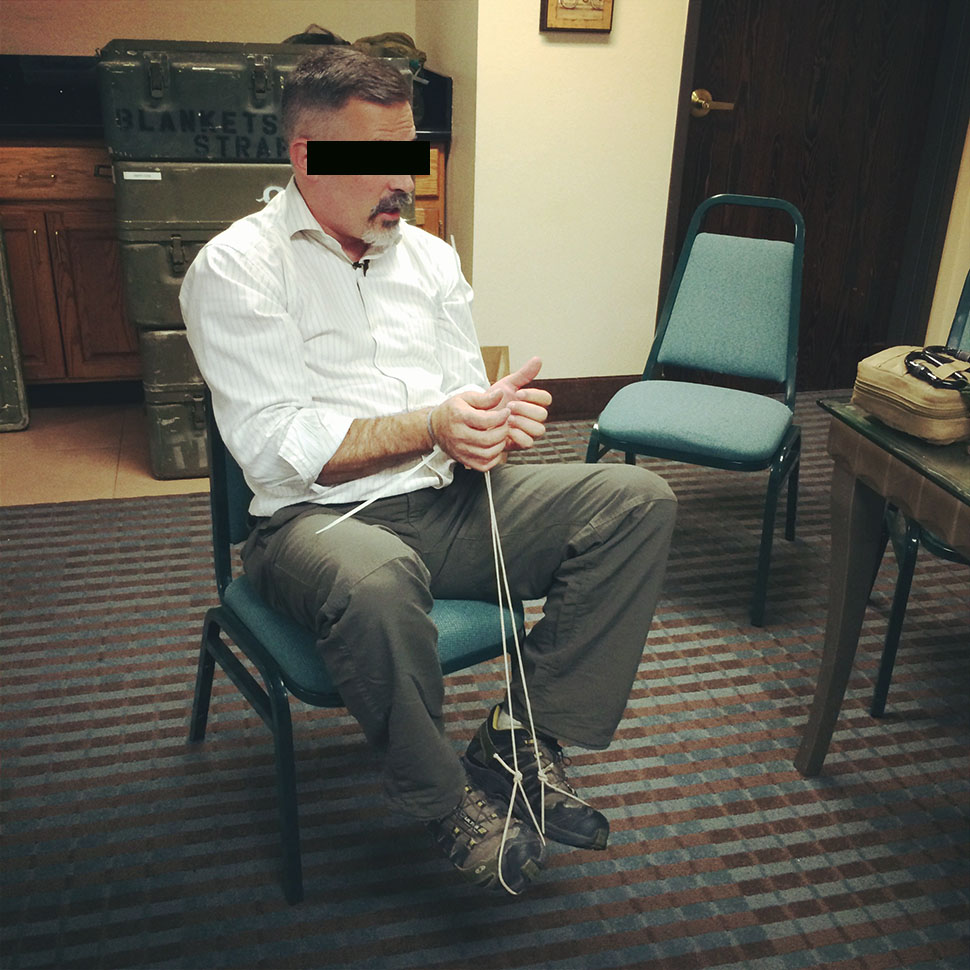
It was roughly at this point in the day’s training that we learned how to make improvised weapons. Some of these were awesome; others were silly; some were disconcertingly easy to assemble. Get onto an aeroplane, for instance, with a bandanna in your pocket and a lock nut in your backpack — and you have the ingredients for a deadly striking weapon.
I mention the aeroplane very deliberately: at this point, the door to the room we were in was wide open and hotel staff were walking past past the entrance or even coming into and out of the room. Reeve was saying things like “you can carry weapons” onto an aeroplane — in fact, as long as you break down any improvised weapons into their component parts, no one will think twice about letting you bring them on board. Think about the bandanna and the lock nut, or a pair of REI carabiners used as brass knuckles, or even a credit card and a disposable razor (I’ll let you take the course to find out what to do with them).
While hotel staff milled about, Reeve told us about a colleague of his who had been hired by the TSA to analyse aeroplane interiors for their potential weaponization. This man rapidly came to the conclusion, Reeve explained, that things like the seat-back tray table could be detached, its arms turned into a stabbing weapon, and the tray table itself into a club, shield, or both. “He essentially disassembled parts of the aeroplane and turned them into weapons,” Reeve said according to my hand-written notes. “You can weaponize anything.”
What the hotel staff must have thought hearing all this literally made me laugh out loud — but, luckily, we made it through the weekend without being raided by the FBI.
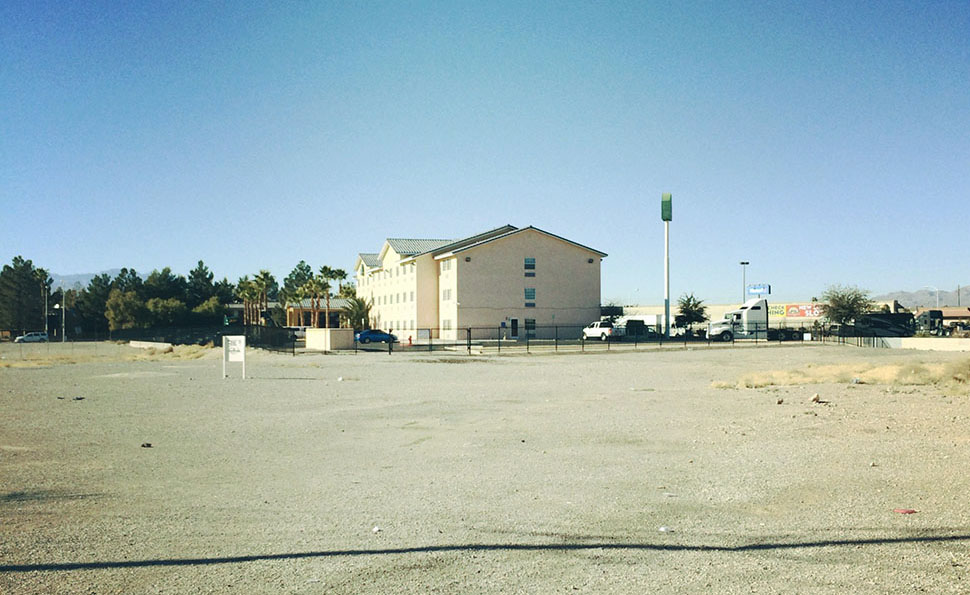
By this point, we had escaped from handcuffs, zip ties, duct tape, and more, and we had made improvised weapons from deconstructed objects found all around us in everyday life.
We had escaped, in other words; now we had to learn to evade.
“How do you stay alive? How do you get to safety on your own?”
This is the final hurdle: the breaking out, the great escape, the flight to freedom, remaining invisible and evasive on our way back to safety.
This final stretch of the workshop was thus more of an inversion of where we began, looking at how to navigate unfamiliar urban environments, how to blend in with local crowds and customs, and how to find shelter in abandoned buildings.
This time around, however, while we cycled back through some of the earlier material, we added how to steal a car (and drive with life-saving aggression), how to make camouflage (specifically, face paint) using the grime from above a car’s muffler, and even a few basic points of urban free-running or parkour: scaling chain-link fences in smooth sequences of movement, for example, or crossing over barbed wire and timing leaps from one floor to another in order to pass through buildings like Jason Bourne.
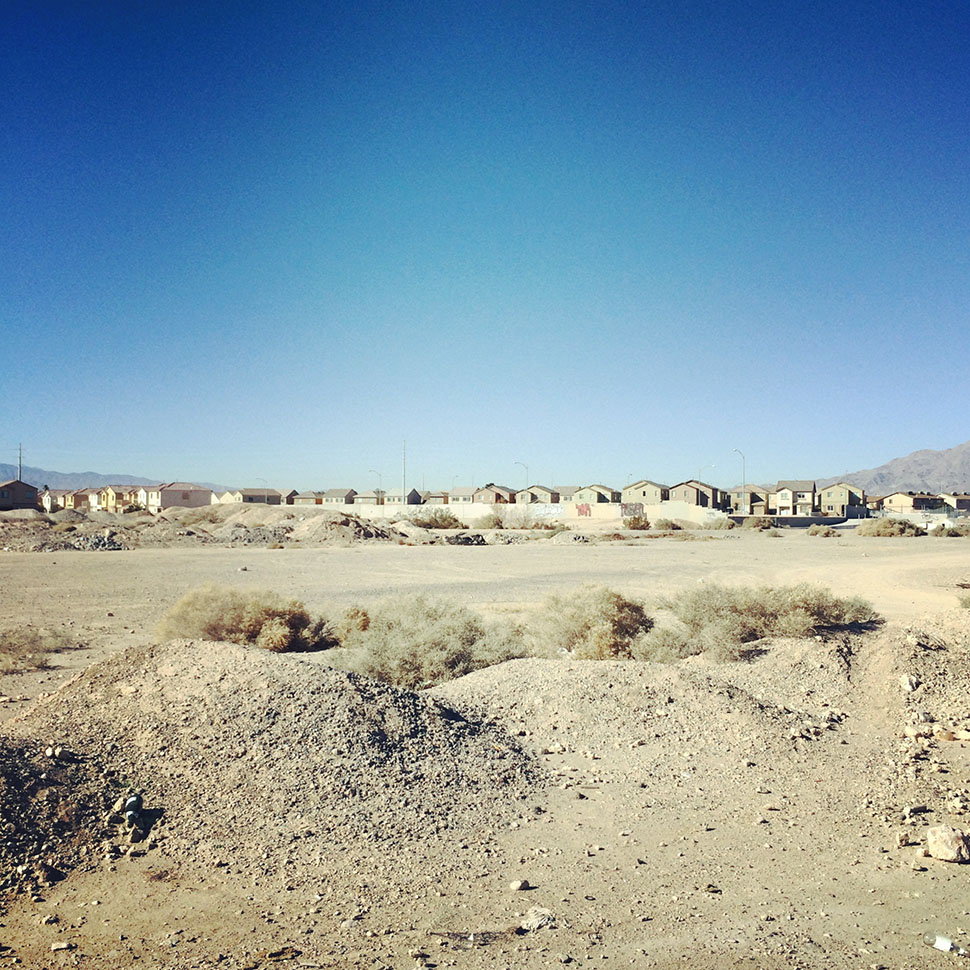
Another glimpse of the wasteland outside the hotel we were training in.
To be honest, this was where the workshop fell into a bit of a lull for me. Seen from a distance, it was a room full of grown adults — only one of whom was female — watching parkour videos on YouTube, surrounded by improvised weapons and lock pick tools, with the shades drawn against the hot desert sun. The notion of escaping from well-armed captors suddenly felt like absurd posturing, as if a group of Tom Clancy-reading 15 year-olds had rented a room in the local La Quinta only to watch action films over cans of sugared energy drinks and talk about how scary it is to visit Detroit.
On the other hand, this was just training: we were there precisely to watch videos and to talk and to take notes, not invade a local drug lord’s palace or scale the walls of the police station under cover of night.
Indeed, how we could put these skills to use was the ultimate question of the workshop. This not only formed the premise of our final activities — being hooded, questioned, hand-cuffed, and asked to evade the ersatz bounty hunters on our way back to downtown Vegas — but also, and far more importantly, gives you the techniques you need (assuming you don’t panic) if you are ever kidnapped for real, bound by your wrists, hooded, and taken to an unfamiliar location.
Again, though, the point of this post is not to give away the details that you’d otherwise learn if you sign up for one of OnPoint Tactical’s courses. Ideological and political disagreements aside, it’s worth it if for no other reason than the surreality of undertaking these exercises with complete strangers in the breakfast room of a cheap motel.
Two of the workshop attendees were there to film a short segment for Oliver North’s Frontlines show on Life of Duty TV, a job that brings them around the world to cities and landscapes where they might, in fact, face possible abduction, and the workshop’s lone female student was preparing for a trip to East Africa. I, of course, was simply flying home to a thoroughly middle class life in Brooklyn the next day.
But I’m curious if your own line of work or lifestyle puts you at potential risk of kidnapping, and if all this training might, in fact, be something you need. If you’ve taken a course like this — or even this specific course from OnPoint Tactical — I’d love to read your own biggest take-aways in the comments below. [OnPoint Tactical]
